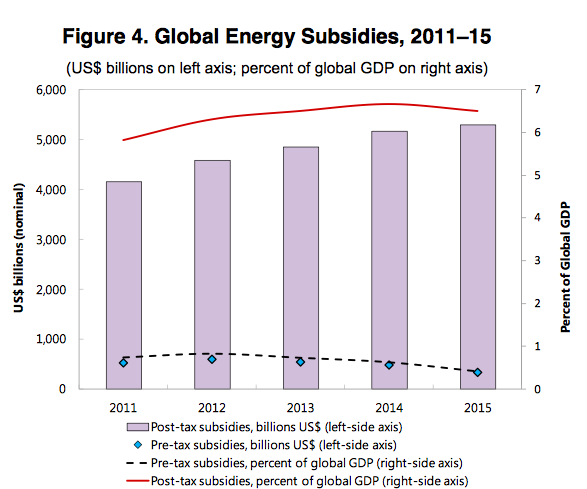Consumers worldwide enjoy an annual global energy subsidy equivalent to about $5.3 trillion dollars, according to a new study by the International Monetary Fund. Reforming how we price the consumption of different types of energy, the authors argue, would not only offer substantial fiscal benefits but would also reduce health care costs and environmental damage.
Authors, David Coady, Ian Parry, Louis Sears and Baoping Shang define subsidies as anything that protects energy consumers from paying the full cost of energy use. This includes both pre-tax and post-tax subsidies.
Related: Fixing America’s Dilapidated Infrastructure Will Cost More If We Wait
Pre-tax subsidies arise when consumers are charged less for energy than providers pay to deliver it. Post-tax subsidies exist when the price paid by consumers is lower than the cost of delivering energy, plus both standard consumption taxes and a “Pigouvian” tax, which accounts for the environmental damage associated with using energy.

The authors concede that they were required to make a number of assumptions about the precise costs of environmental damage across various countries. However, they argue, “the key findings of the paper are clear: energy subsidies are very large; their removal would generate very substantial environmental, revenue and welfare gains; and their reform should begin immediately, albeit gradually, given the uncertainty over the precise level of energy taxes required.”
Among other things, they argue, reducing the price of energy to a level below the true cost to society is fiscally unsound.
“Energy subsidies impose large fiscal costs, which need to be financed by some combination of higher public debt, higher tax burdens and crowding out of potentially productive public spending (for example, on health, education, and infrastructure), all of which can be a drag on economic growth,” they write.
Related: How Obamacare Could Be Squeezing Consumer Spending
By keeping prices for traditional fossil fuels low, governments also “increase the vulnerability of countries to volatile international energy prices.”
The findings of the paper could influence decisions made later this year in Paris when the United Nations Climate Change Conference assembles to hear the pledges of various nations around the world to reduce their emissions of carbon.
The paper also comes just days after reports that China reduced its carbon emissions by 5 percent in the first four months of 2015, a surprisingly large drop that is being attributed to the country’s move away from the use of coal as a primary fuel. The Chinese government has reportedly shuttered up to 1,000 coal mines, and the country’s overall coal production is down 7.4 percent year-over-year.
Top Reads from The Fiscal Times




